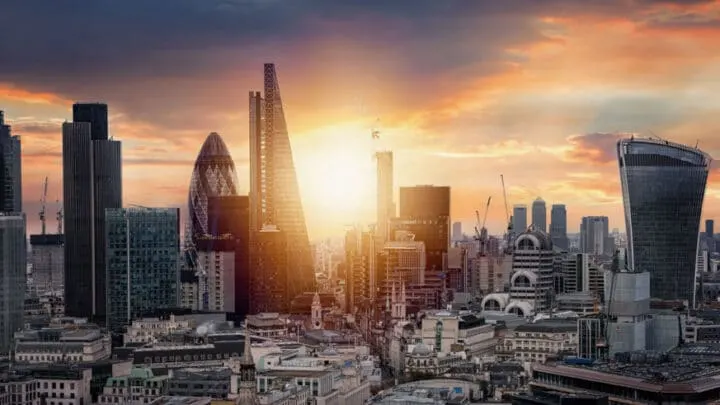What’s what on the London skyline? Here’s where you find out.
Nothing beats a panoramic view of London’s skyline, but have you ever wondered what’s what?
Whether you’re taking a peek from an aeroplane or grabbing an eyeful from ground level, it’s time to discover some of the London skyline’s most iconic (and funny-shaped) buildings.
Iconic Buildings of London’s Skyline
30 St Mary Axe / The Gherkin
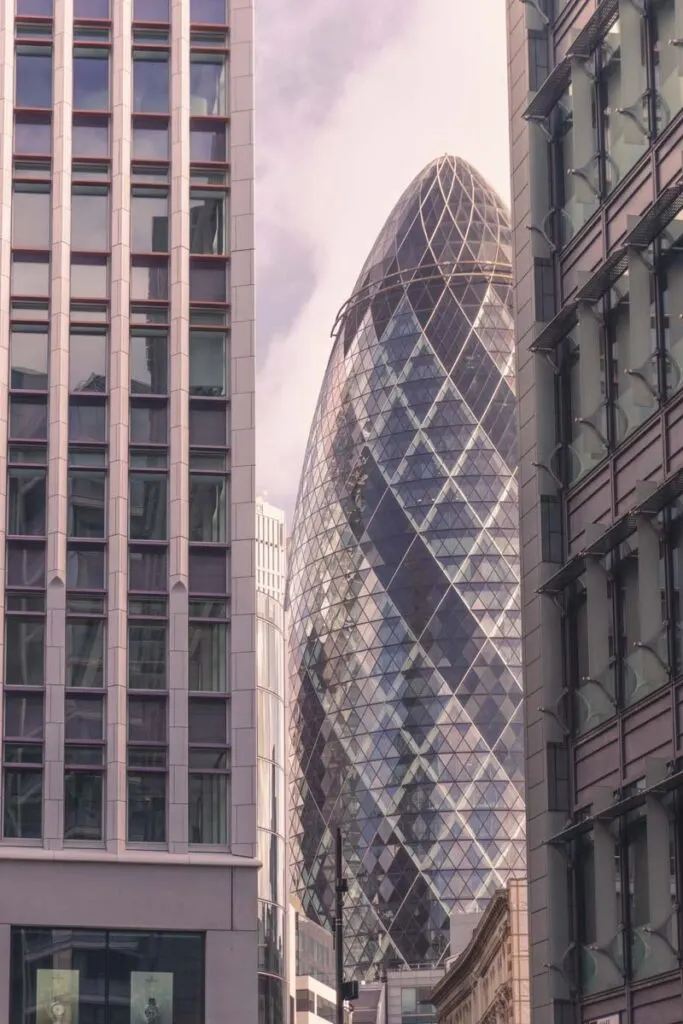
Let’s begin with one of the most recognisable buildings on the London skyline, 30 St Mary Axe, aka ‘The Gherkin’.
The bullet-shaped skyscraper with its diamond shaped windows was built in 2003 by renowned British architect Norman Foster and it can be spotted from as far as Windsor Great Park.
Situated in the City of London, it sits on the site of the former Baltic Exchange which was badly damaged in a 1992 IRA bombing. The distinctive ‘lens’ atop the Gherkin pays homage to an iconic glass dome which was on the ground floor of the original building and is now displayed at the National Maritime Museum.
20 Fenchurch St / The Walkie Talkie
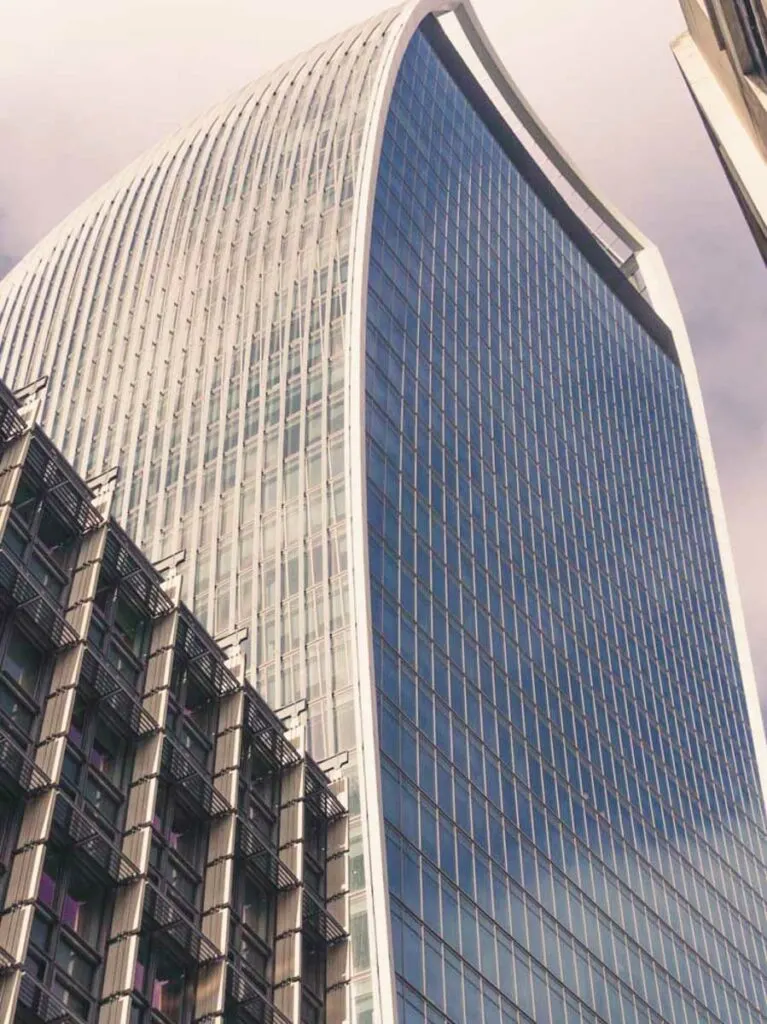
Giving off all the ‘mobile phone from the 1980s’ vibes – it’s not hard to see how the distinctive shape of the Walkie Talkie earned it its nickname.
Nicknames aside, it came to fame for something a little more dramatic: being the building that melted a car.
It was discovered during construction that the concave shape caused the sun to reflect onto the street below, reaching temperatures of up to 117 °C. It melted the bodywork of a car and a journalist from City A.M. literally managed to fry an egg on the ground in front of it. Sizzling.
They’ve fixed all that now, so these days 20 Fenchurch Street is best-known for the fabulous plant-filled Sky Garden where you can see cracking views of the city – for free!
The Shard
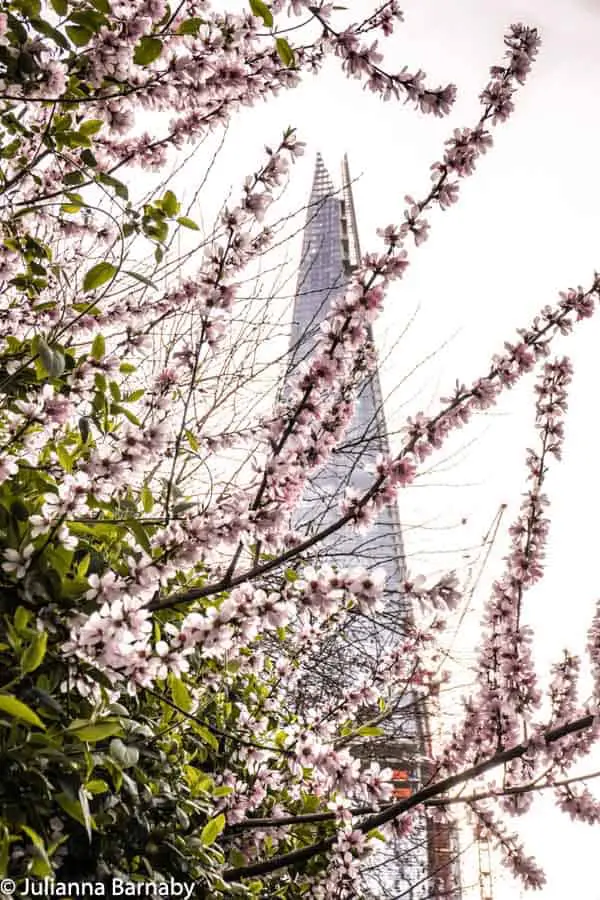
Love it or hate it, The Shard in London Bridge stands proud at 309.6 metres and you’ll be able to see its glittering angled panes of glass reflecting London’s skies from all over the capital.
The Shard’s architect Renzo Piano took his inspiration from the London spires depicted by 18th-century painter Canaletto.
Its name derives from the scathing words of English Heritage, who deemed it ‘a shard of glass through the heart of historic London’.
When it was completed in March 2012, The Shard was the tallest building in Europe. The View from the Shard on the 72nd floor is now one of London’s top attractions and is well worth a visit for breathtaking views of the city.
City Hall
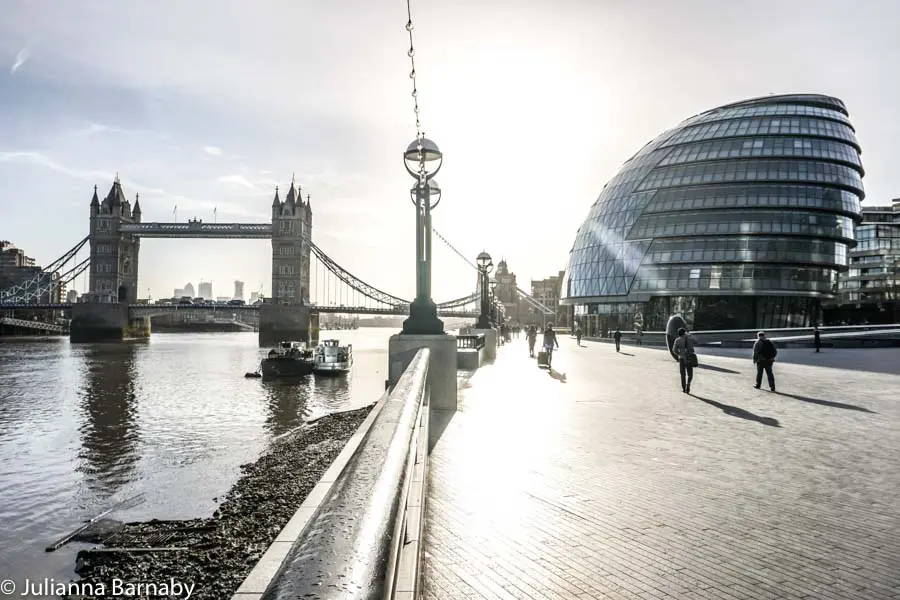
On the south side of the river, a stone’s throw from Tower Bridge you’ll notice a slanted bulbous building resembling a motorcyclist’s helmet. You’re looking at City Hall – another iconic work of architecture by Norman Foster which opened in 2002.
It’s the current home to the Greater London Authority (the Mayor of London and the London Assembly) although Mayor Sadiq Khan is planning to move into The Crystal building in Royal Victoria Docks at the end of 2021.
You’ll also find the cool open-air Scoop Amphitheatre just beneath where there’s always plenty of goings-on, particularly in the summer months.
St Paul’s Cathedral
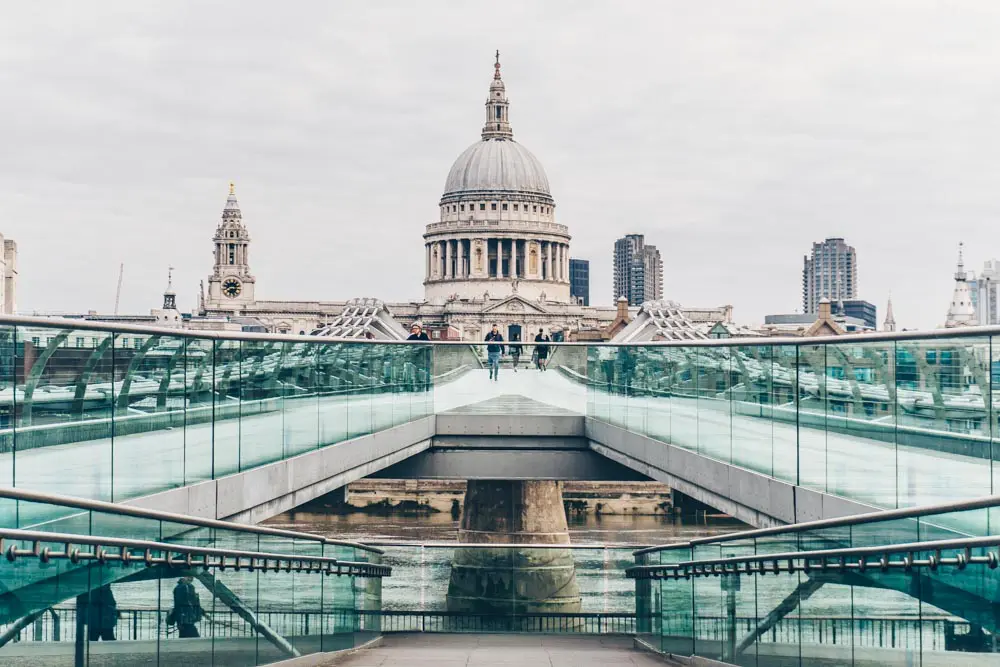
With its enormous dome and Baroque inspired architecture, St. Paul’s has to be one of the most recognisable and iconic buildings on the London skyline.
For a long time (between 1710 and 1963) it was the tallest building in London and remains the UK’s second-largest church building after Liverpool Cathedral.
Sir Christopher Wren was commissioned to build the cathedral as part of a huge building programme after the Great Fire of London in 1666. The new building was only declared officially complete however in 1711.
Numerous royal events have been held here including a smattering of weddings. It was also where the funerals of Admiral Nelson, Winston Churchill and Margaret Thatcher took place.
The interior of St. Paul’s is of course just as breathtaking – well worth a visit.
One Canada Square
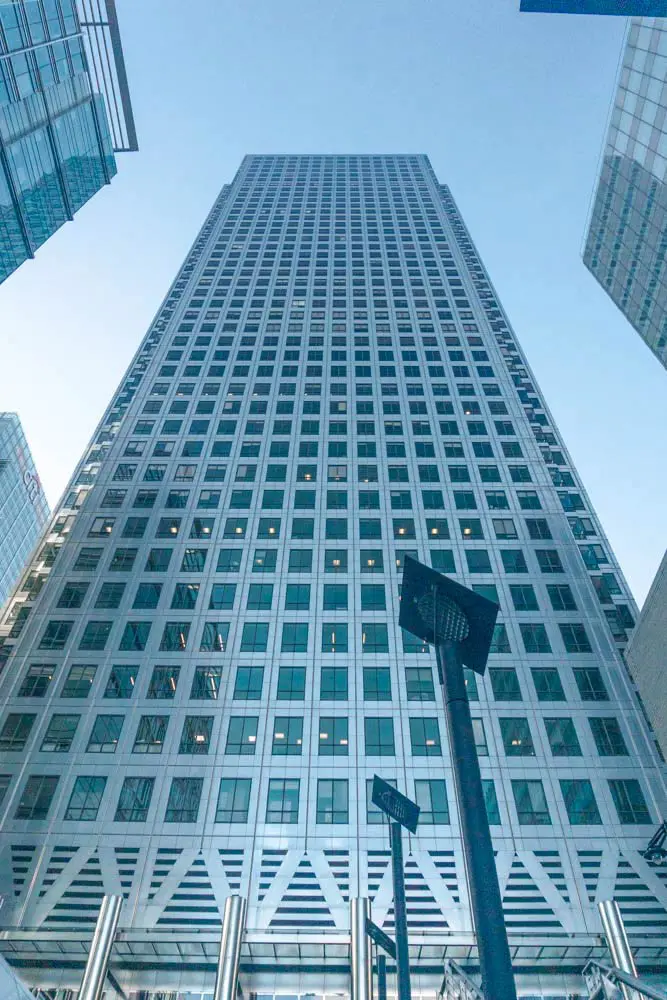
‘I would personally go mad if I had to work in a place like that’ came the damning words of Prince Charles in response to the completion of One Canada Square in 1991.
The pointy skyscraper with the flashing light on the top is still one of the most prominent buildings on the Canary Wharf skyline. With its signature pyramid pinnacle that encloses an aircraft warning beacon, it stands at 235 metres tall, making it the UK’s third tallest building.
It was supposed to be even taller but floors had to be taken off to comply with air traffic safety regulations. Argentine architect César Pelli took inspiration from Big Ben for the shape. It was also clad in steel to reflect Britain’s industrial heritage.
Salesforce Tower
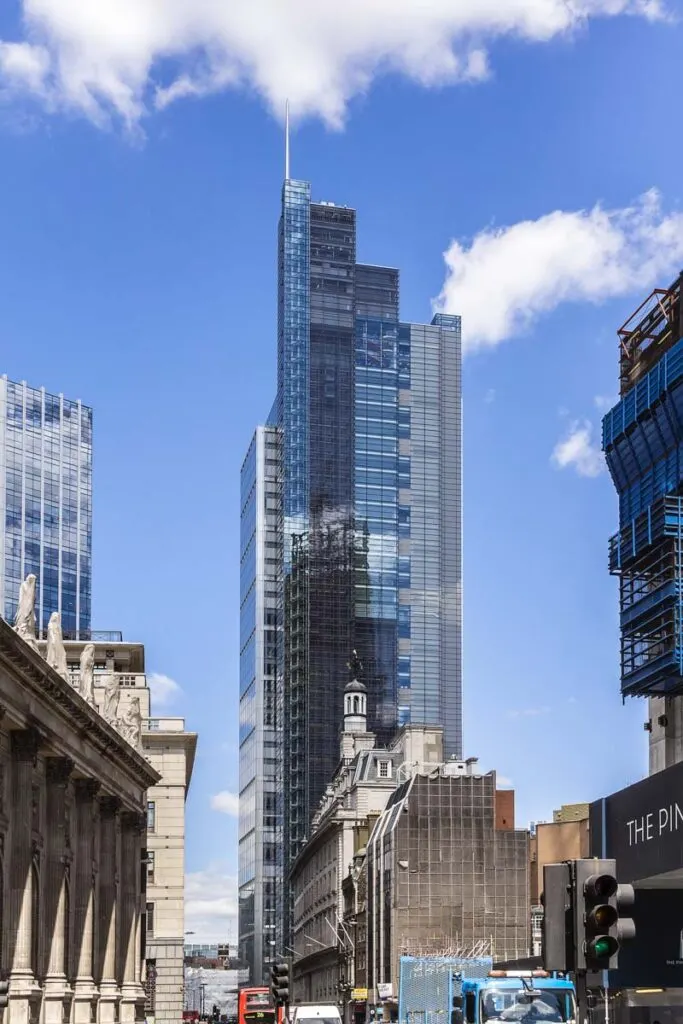
Previously known as the Heron Tower, Salesforce Tower is the second tallest building in the City of London’s financial district and was completed in 2011.
Two acclaimed restaurants are open to the public on the top floors of the tower, Sushi Samba and Duck and Waffle – London’s iconic 24h restaurant. Delicious food, outdoor terraces and awesome views certainly make for a special night in the city.
A surprising feature of the building is the enormous aquarium at street level which contains over 60 species of fish. Give a wave to one of the divers cleaning the tank next time you’re passing.
The Leadenhall Building / The Cheesegrater
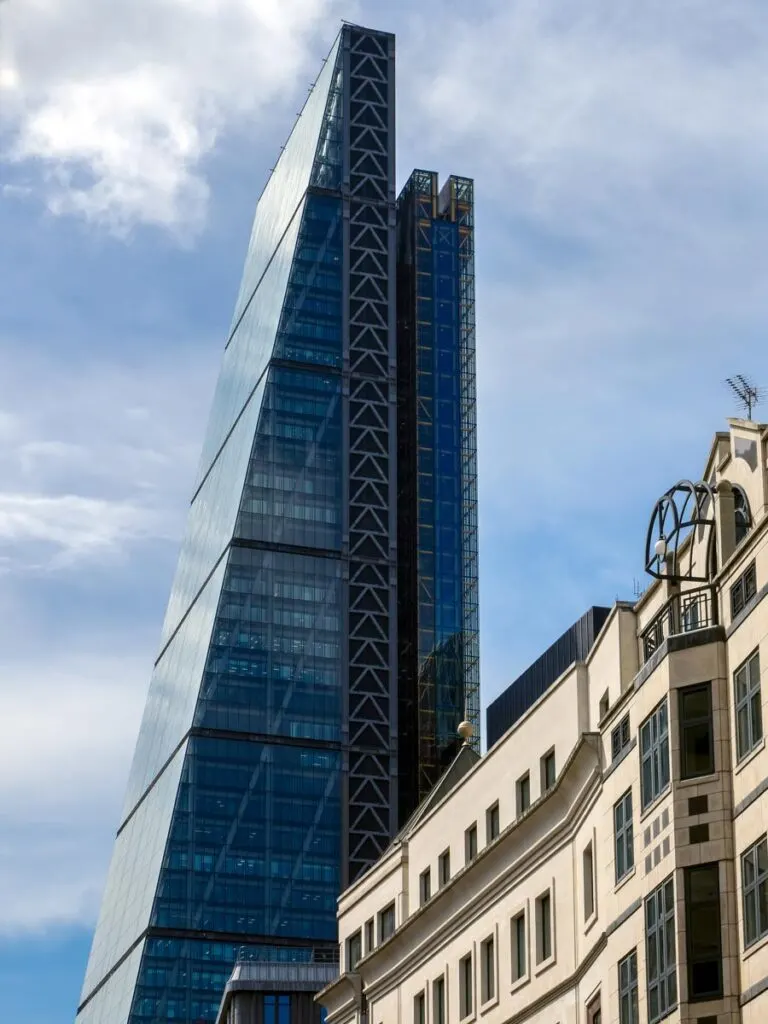
This wedge of a building is 225 metres tall and was built in 2014 by Richard Rogers. Name sound familiar? He’s the architect perhaps most famed for designing the Pompidou Centre in Paris, the City of London’s Lloyd’s Building and the Millenium Dome in Greenwich.
The Cheesegrater nickname came from the City of London Corporation’s chief planning officer. When he first saw the model of the building, he told the architect that ‘he could imagine his wife using it to grate parmesan’.
Look out for the lifts and elevator shafts of the building which were painted orange to create an architectural feature.
Palace of Westminster
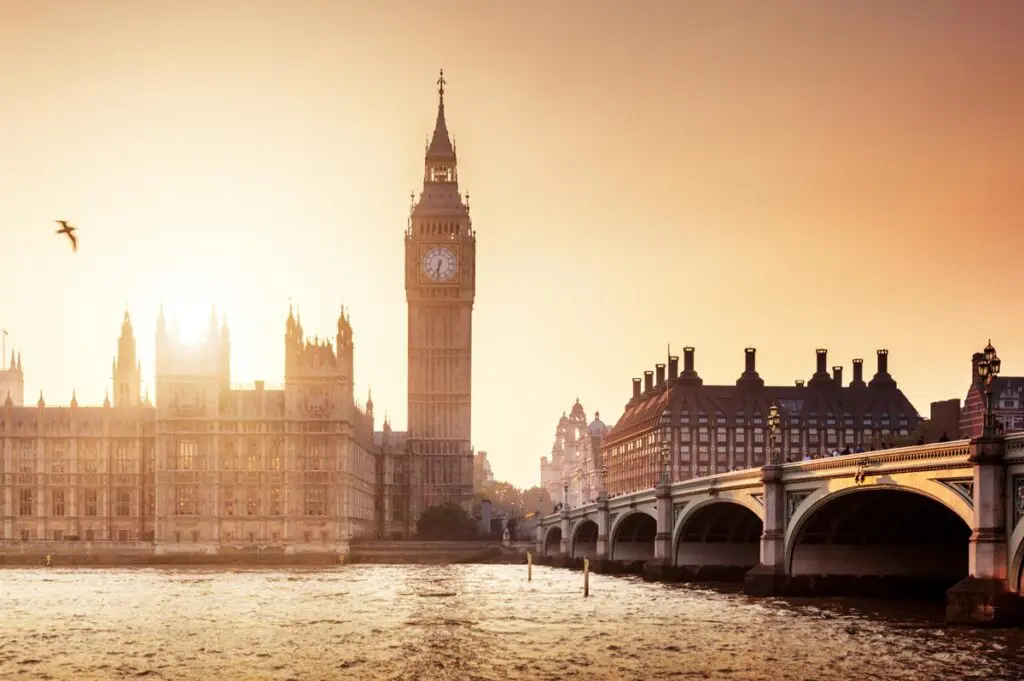
The Gothic spires of the Palace of Westminster – specifically Elizabeth Tower that holds the Big Ben bell – are quite possibly THE most iconic images of London. Londoners and tourists alike just can’t get enough of Big Ben’s bongs – currently silent due to renovation work.
The site of the Palace of Westminster was home to the Kings of England way back in the 11th century and the Houses of Parliament have been based here since the 13th century.
Not much remains of the medieval site which was largely destroyed by a raging fire in 1834. The new Gothic structure was built in the mid to late 19th-century by Charles Barry and Augustus Pugin, who both died before it was completed.
Battersea Power Station
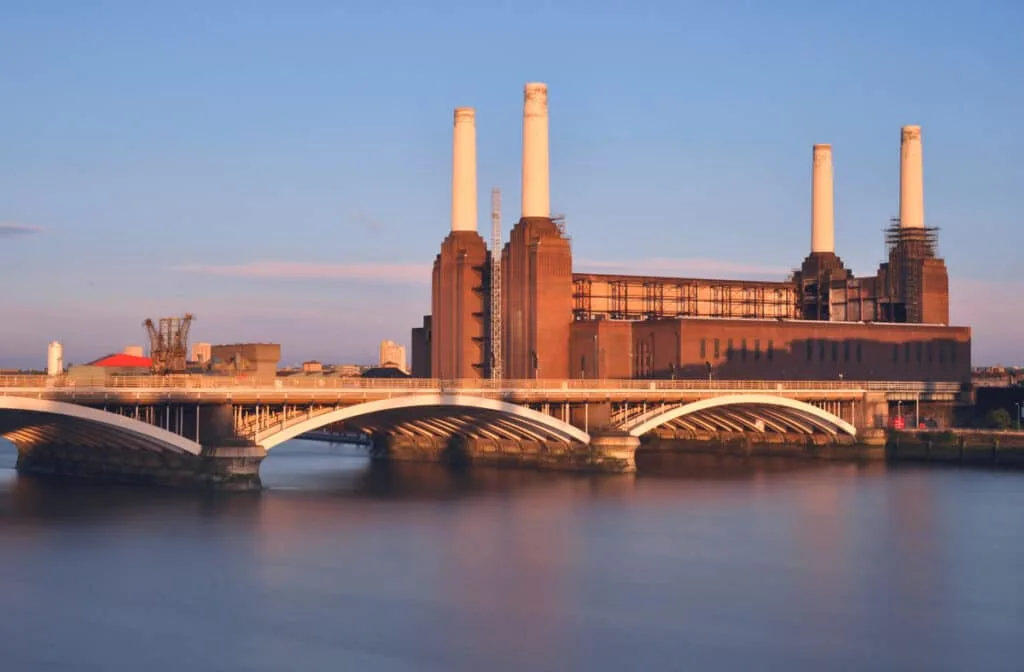
The characteristic four white towers of Battersea Power Station are easily spotted on the London horizon.
The huge Grade II* listed coal-fired power station, decommissioned 1975-1983, is situated on the south bank of the River Thames. Its architect, George Gilbert Scott, also built Bankside power station, now the Tate Modern.
Plus it owes part of its fame to its appearance on Pink Floyd’s 1977 ‘Animals’ album cover with an inflatable pig.
Although it’s known as Battersea Power Station – it actually consists of two power stations which were built in stages between 1929 and 1955. After being fully decommissioned in 1983 it remained derelict for decades, but it still retains its stunning Art Deco structure.
There were numerous ideas for its redevelopment from a theme park to a football stadium, all of which seemed to fizzle out.
Thankfully, the site’s latest redevelopment is well underway, with a new Battersea Power Station tube station now open on the Northern Line. Circus West Village is thriving with new flats, shops and restaurants – a hub of activity that’s well worth a visit.
BT Tower
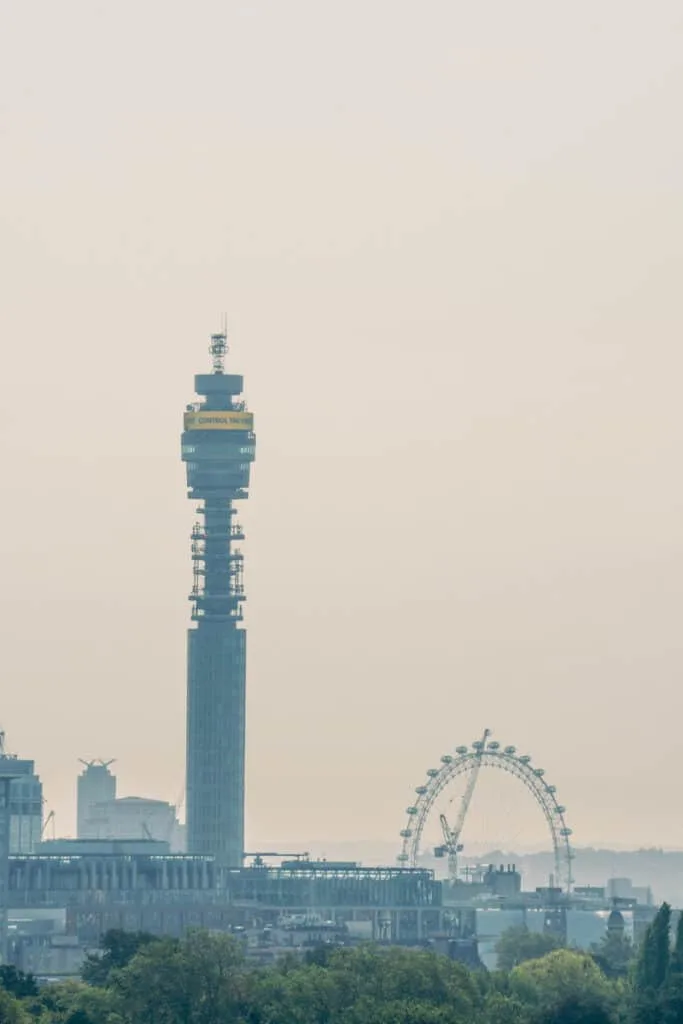
One of the older members of the London city skyline is this Grade II listed communications tower, BT Tower in Fitzrovia which (aerial rigging included) stands at 189 metres tall.
Completed in 1964, it took over the mantle from St Paul’s as the tallest building in the UK until 1980, when it was superseded by the NatWest Tower.
Groundbreaking for its time was the state-of-the-art rotating restaurant on the 34th floor which made one rotation every 23 minutes. The London attraction ‘Top of the Tower’ was opened to the public by the Queen.
The tower closed to the public in 1981 following a bomb attack by a far-left anarchist group. Nowaday, you’ll notice the 360-degree LED ‘information band’ by night, which was installed in 2009. It’s still in use as a UK communications hub and more recently, an urban atmospheric pollution observatory.
Twentytwo Bishopsgate
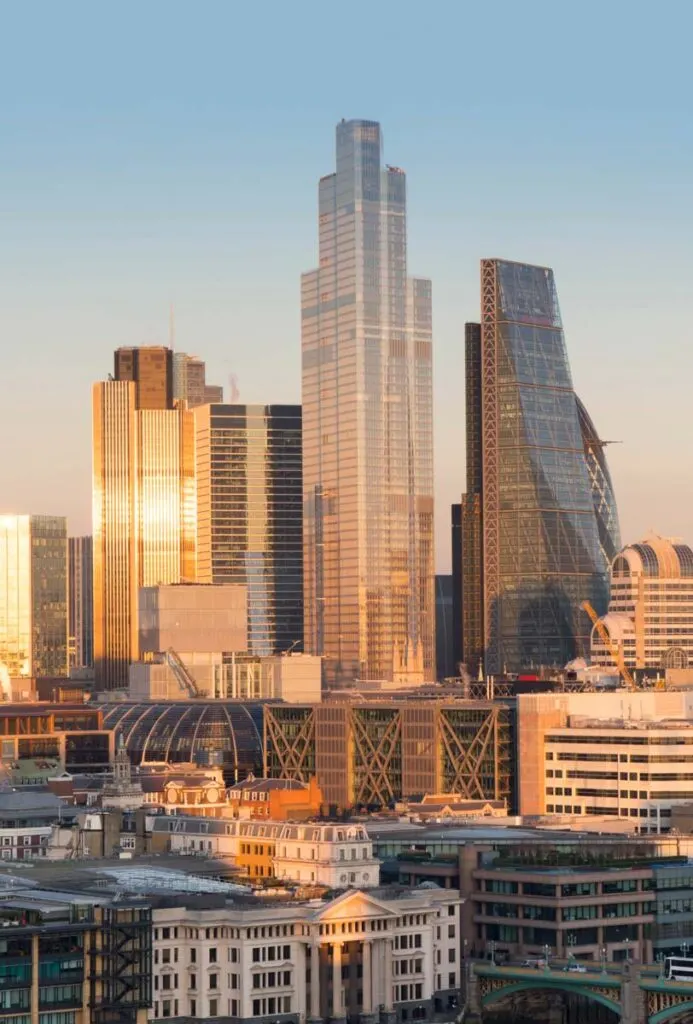
At just over 195,000 square metres, Twentytwo (22 Bishopsgate) is huge.
Finally completed in 2020, construction had actually started in 2008 but was suspended in 2012 (at seven storeys high) due to the Great Recession.
It was initially going to be a 288m ‘helter skelter’ shaped tower named The Pinnacle. Several redesigns later – partly due to concerns from the Civil Aviation Authority, the 62-storey office building now stands at 278m tall making it the tallest in London’s financial district and the second tallest building in the UK after The Shard.
The viewing gallery is not yet open to the public, but will be free of charge.
52-54 Lime Street / The Scalpel
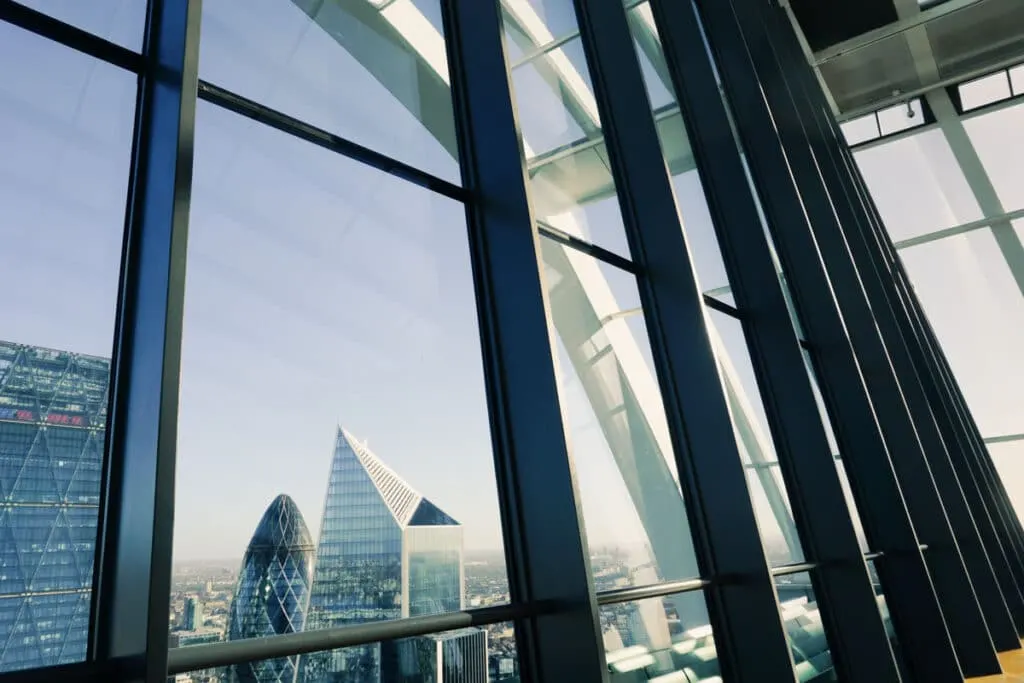
Sitting amidst the Walkie Talkie, the Gherkin and the Cheese Grater, another building has joined the gang.
Finished in 2020, The Scalpel popped up onto the London skyline while many of us were busy working from home.
It’s an elegant origami-shaped office building on Lime Street, 190 metres tall. The architects deliberately designed it to fit in with the existing cluster of buildings in The City as if they were in conversation with one another, whilst protecting views of St Paul’s Cathedral.
Look out for the stone relief sculptures at street level depicting classical elements of earth, air, fire and water by sculptor James Woodford.
Strata SE1
Yet another familiar building that dominates the skyline in London is Elephant and Castle’s Strata SE1, sometimes referred to as ‘The Razor’. It was completed in 2010 when Boris Johnson was Mayor of London, who also nicknamed it ‘The Lipstick’.
It’s a 147-metre-high residential building and is easy to spot because of the distinctive three wind turbines on the top. These were intended to power 8% of the energy needs of the building. There has however been some scepticism (and accusations of greenwashing) over this, as residents reported they have barely moved.
Landmark Pinnacle
There are a fair few skyscrapers on the Isle of Dogs peninsula, but you may have noticed during a walk through the east of the city, that something new has appeared in recent years.
At 233 metres tall, Landmark Pinnacle towers over all the others on the east London skyline and if vertigo is no problem, you can also buy a flat there.
Built in 2020, this is one of the tallest residential buildings in Europe, comprising 822 residential units as well as 162 serviced apartments and amenities.
The Tate Modern
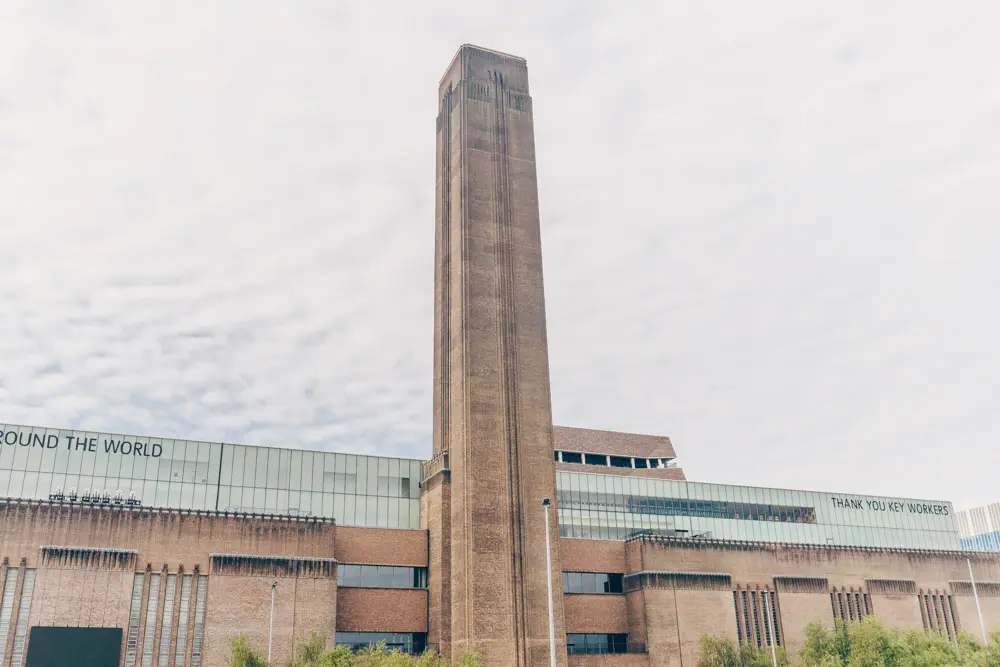
Another grand power station that can be spotted from a mile off is The Tate Modern. The massive structure dominates the riverside, and the art-museum scene worldwide. They’ve got pictures by some of the most notable names in the business, and an incredible array of temporary exhibitions to supplement the masterpieces.
The building wasn’t always home to some of the world’s best art though. It used to be The Bankside Power Station, designed by George Gilbert Scott architect of Battersea Power Station (seems he had quite a racket going on), and powered the printing presses on Fleet Street in the days of old.
It was put out of commission in 1981 after 90 years of operation because it wasn’t running as efficiently as modern power plants, and was polluting. The Tate moved in in 2000.
The London Eye
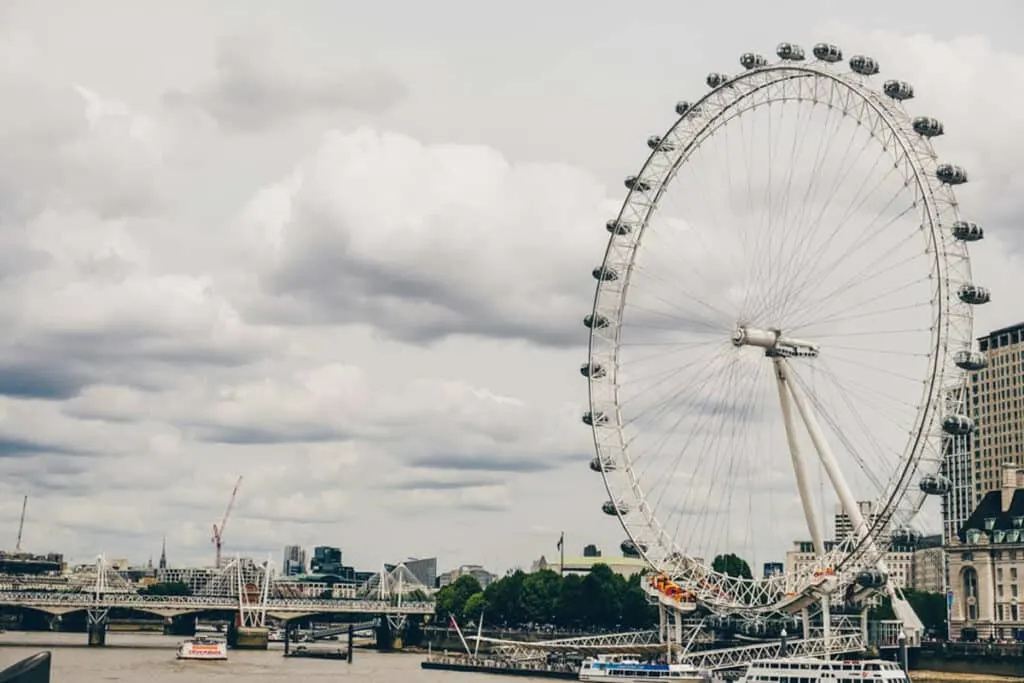
OK, shoot us down. The London Eye isn’t a building. It is, however, one of London’s most iconic structures, and is silhouetted on all the skyline shots on mugs, postcards, tourist tea towels and trinkety tat you see in gift shops and tourist traps across the city. It is, also, pretty interesting.
For one, did you know that a husband-and-wife team designed the wheel for a competition? Or that it’s the biggest observation wheel in Europe? How about the fact that although it was set to be The Millennium Wheel, it actually missed the Millennium by a few months? Yep, customers weren’t allowed on until March 2000 because of safety concerns.
Obviously it’s totally safe now though, and one hell of a way to see London.
London Skyline: Practical Tips
- Looking for the best spots to take in London’s skyline in all its glory? There are plenty of great hills with stunning views you should know about. We’ve written all about them in one handy guide, right here. Or if you fancy spotting iconic landmarks with a drink in your hand, check out these cool rooftop bars.
- You don’t have to observe these buildings from afar. Some of them have viewing platforms, and some have restaurants and cafes in them too. Then, of course, you could always get a high-flying office job in one of them.

